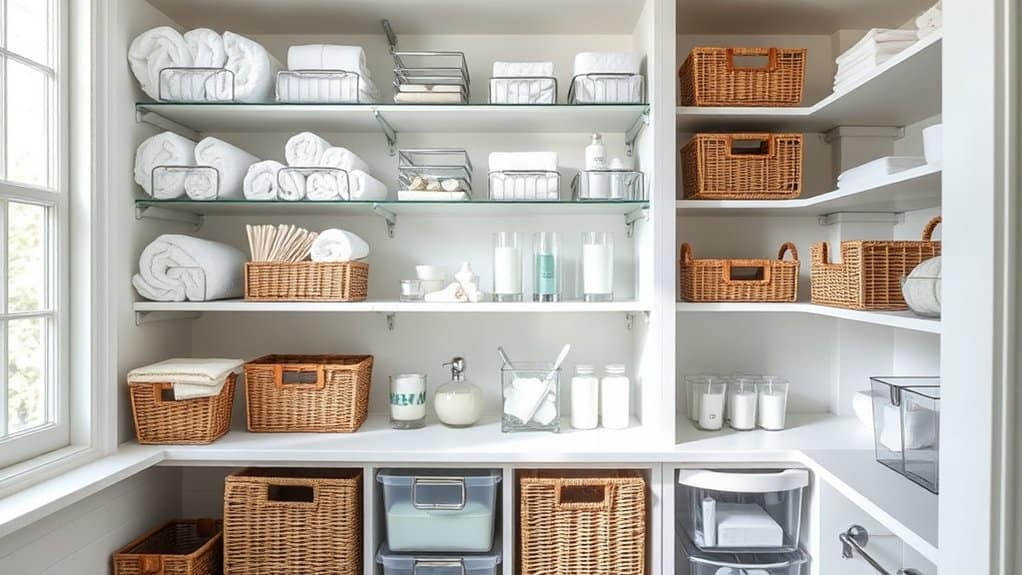Is your bathroom closet a chaotic jumble of half-empty shampoo bottles and forgotten lotions? You’re not alone! I’ve discovered seven game-changing organization hacks that’ll transform your space from messy to magnificent. After struggling with my own bathroom storage nightmare, I’ve tested these solutions and can’t believe the difference they’ve made. Ready to turn your cluttered closet into an Instagram-worthy storage dream? Let’s explore these simple but brilliant tricks that’ll make your morning routine so much smoother.
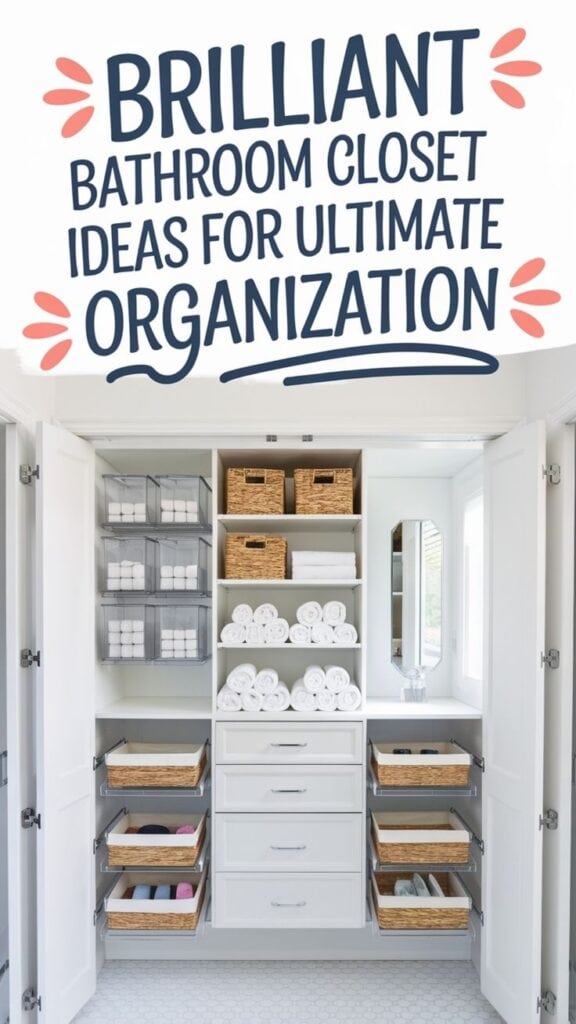
Install Over-the-Door Storage Solutions
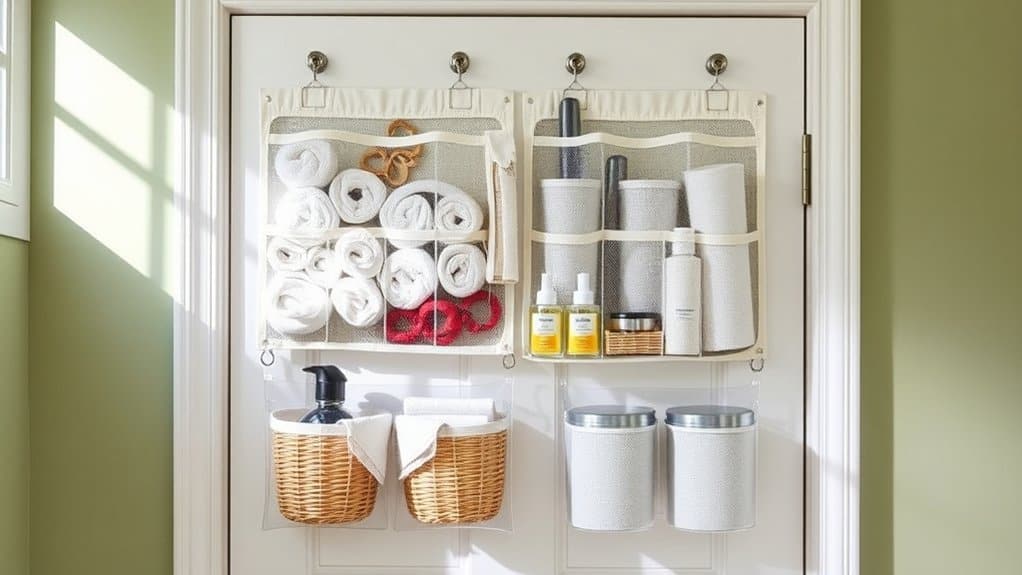
Making the most of vertical space in a bathroom is crucial, especially in smaller homes where storage space comes at a premium. Over-the-door storage solutions offer an excellent way to maximize unused space while keeping everyday items easily accessible and organized.
These storage systems transform the often-overlooked door space into a functional storage area, perfect for toiletries, hair accessories, cleaning supplies, or even towels. When properly installed, they provide instant organization without taking up valuable floor or counter space, making them an ideal solution for bathrooms of any size.
Required Items:
- Over-the-door hanging organizer
- Measuring tape
- Level
- Screwdriver
- Door hooks or brackets
- Command strips (optional)
- Storage bins or baskets
- Labels
- Door bumpers
Begin by measuring your bathroom door’s dimensions, including thickness, to ensure proper fit of the over-door organizer. Install door bumpers at the top and bottom of the door to prevent damage to both the door and the organizer.
Place the hanging brackets or hooks over the door, ensuring they’re level and secure. If using an organizer with pre-installed hooks, simply hang it directly over the door, adjusting as needed for balance. For added stability, especially with heavier items, consider securing the bottom corners with command strips.
Sort items by category before placing them in the organizer. Store frequently used items at eye level, heavier items in lower pockets or shelves, and lighter, less-used items up top.
Consider using clear storage bins within larger pockets to keep smaller items contained and visible.
Additional Tip: Label each pocket or section clearly to maintain organization long-term, and regularly assess the contents to prevent overloading the organizer. Consider rotating seasonal items and removing products you no longer use to maintain an efficient storage system that doesn’t strain your door hinges.
Use Clear Storage Bins With Labels
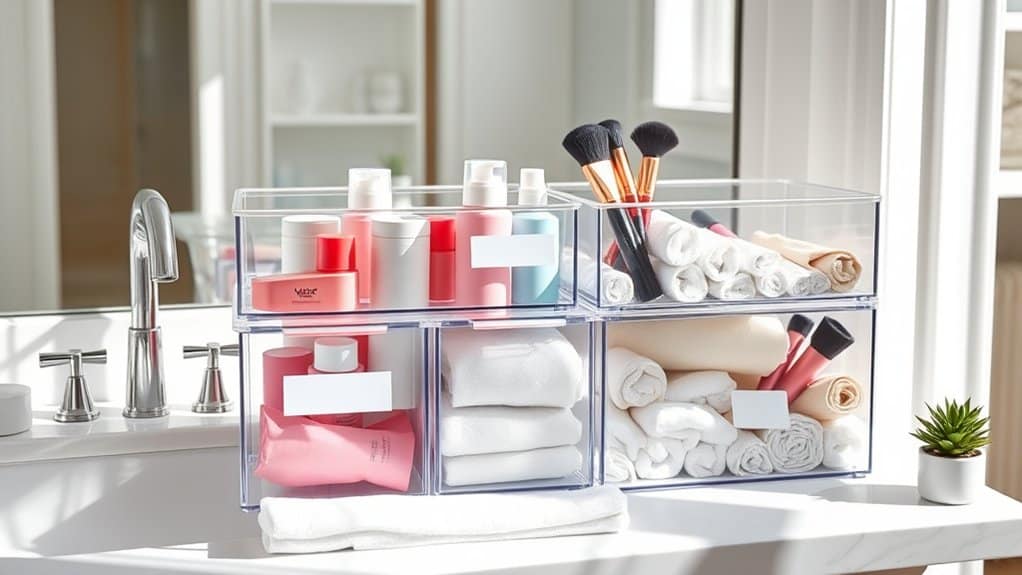
Clear storage bins represent one of the most effective solutions for bathroom organization, offering immediate visibility of contents while maintaining a clean, streamlined appearance. When properly labeled, these containers eliminate the frustration of searching through multiple containers and drawers to find specific items.
The transparency of clear bins, combined with proper labeling, transforms bathroom organization from a constant struggle into an intuitive system. This method works particularly well for families sharing bathroom space, as everyone can quickly locate their items and maintain the organizational system with minimal effort.
Required Items:
- Clear plastic storage bins (various sizes)
- Label maker or waterproof labels
- Waterproof marker
- Measuring tape
- Drawer liner or non-slip mat
- Cleaning supplies
- Category dividers (optional)
- Clear lid containers (optional)
Start by measuring your available storage spaces, including under-sink areas, shelves, and cabinet depths. Sort bathroom items into distinct categories such as hair care, dental hygiene, first aid, and cosmetics. Select appropriately sized clear bins for each category, ensuring they fit your designated spaces.
Place non-slip mats in the bottom of each container to prevent items from sliding around, especially in drawers or under-sink areas. Create clear, water-resistant labels for each container that precisely describe the contents. Position labels on the front and top of containers for easy identification from multiple angles.
Arrange items within each bin vertically when possible, allowing for maximum visibility and easy access. For frequently used items, position bins at eye level or in easily accessible locations.
For optimal organization maintenance, conduct monthly reviews of bin contents, removing expired products and repositioning items based on usage patterns. Consider using stackable containers in areas with vertical space, and implement smaller containers within larger bins for subcategorizing items.
Always leave about 20% of each container empty to accommodate new products and maintain the system’s flexibility.
Create Vertical Storage With Stackable Drawers
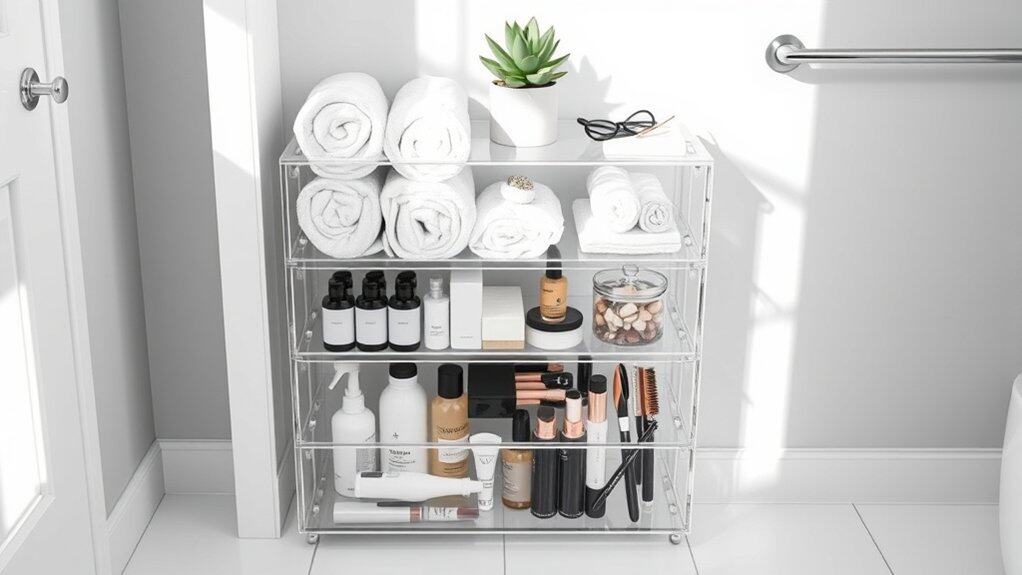
Maximizing vertical space in your bathroom is crucial for creating an organized and clutter-free environment. By utilizing stackable drawers, you can transform unused vertical space into valuable storage areas, making essential items easily accessible while maintaining a clean aesthetic.
Stackable drawer systems provide a practical solution for bathrooms of any size, allowing you to customize storage based on your specific needs. These versatile units can be arranged and rearranged as your storage requirements change, making them an ideal investment for long-term organization.
Required Items:
- Stackable drawer units
- Drawer dividers or organizers
- Label maker or labels
- Measuring tape
- Level
- Non-slip drawer liners
- Clear storage containers (optional)
- Drawer pulls or handles (optional)
Start by measuring your available vertical space, ensuring you select appropriately sized stackable drawer units. Position the base unit against the wall, using a level to ensure it sits perfectly flat.
Add subsequent units, checking that each drawer slides smoothly before stacking the next piece. Secure the units together according to manufacturer instructions if provided.
Once assembled, organize items by category, placing frequently used items in middle drawers for easy access. Install drawer dividers to create designated spaces for smaller items, and use clear containers for products that might leak.
Line each drawer with non-slip material to prevent items from sliding when opening and closing.
Additional Tips:
Maintain your organized drawers by implementing a regular cleaning schedule and periodically reassessing item placement.
Consider using clear drawer fronts or labels to easily identify contents, and keep a step stool nearby if utilizing higher drawers.
Remove items that haven’t been used in six months to prevent clutter accumulation, and wipe down drawer interiors monthly to maintain cleanliness and prevent product residue buildup.
Implement a First-In-First-Out (FIFO) System
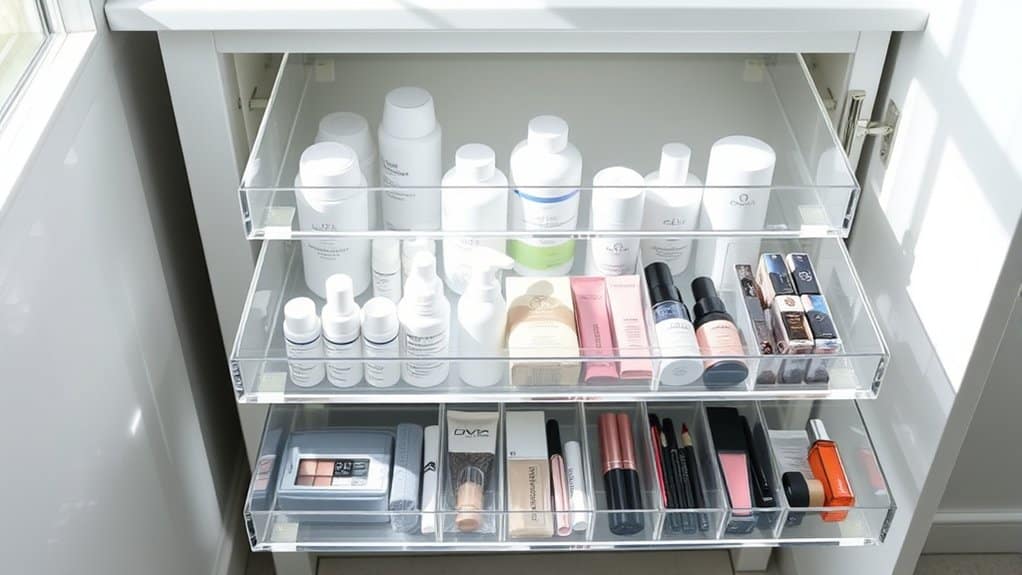
Maintaining an organized bathroom goes beyond mere aesthetics – it’s about creating an efficient system that prevents waste and ensures you’re using products before they expire. A First-In-First-Out (FIFO) system, commonly used in retail and warehousing, can revolutionize your bathroom storage by helping you track and use items in the order they were purchased.
Implementing FIFO in your bathroom prevents the accumulation of expired products, reduces clutter, and helps you maintain a clear inventory of your personal care items. This system is particularly valuable for products with limited shelf life, such as medications, skincare products, and cosmetics, ensuring you use them while they’re still effective and safe.
Required Items:
- Clear storage containers
- Label maker or markers
- Shelf risers
- Drawer dividers
- Storage bins
- Wire baskets
- Clear shower caddies
- Date tracking stickers
- Inventory notepad
To implement a FIFO system, start by completely emptying your bathroom storage spaces and grouping similar items together. Check expiration dates and arrange products with the earliest expiration dates at the front of your storage areas.
Use clear containers or bins to create designated spaces for each category of items, ensuring older products are easily accessible and visible. Install shelf risers or drawer organizers to maximize vertical space and maintain clear sight lines to all products.
Create a simple tracking system by marking purchase dates on products or using a small inventory list. When adding new items, always place them behind or beneath existing products of the same type. This naturally forces you to use older items first as they remain at the front of your storage areas.
For items without clear expiration dates, implement a “purchased on” dating system to maintain product rotation.
To maintain the FIFO system effectively, conduct monthly reviews of your inventory, checking expiration dates and rotating products as needed. Consider using clear containers whenever possible to maintain visibility of products and their expiration dates.
Additionally, resist the urge to stockpile items unless you’re certain they’ll be used before expiring, as this helps maintain the efficiency of your FIFO system and prevents unnecessary waste.
Add Pull-Out Organizers for Deep Shelves
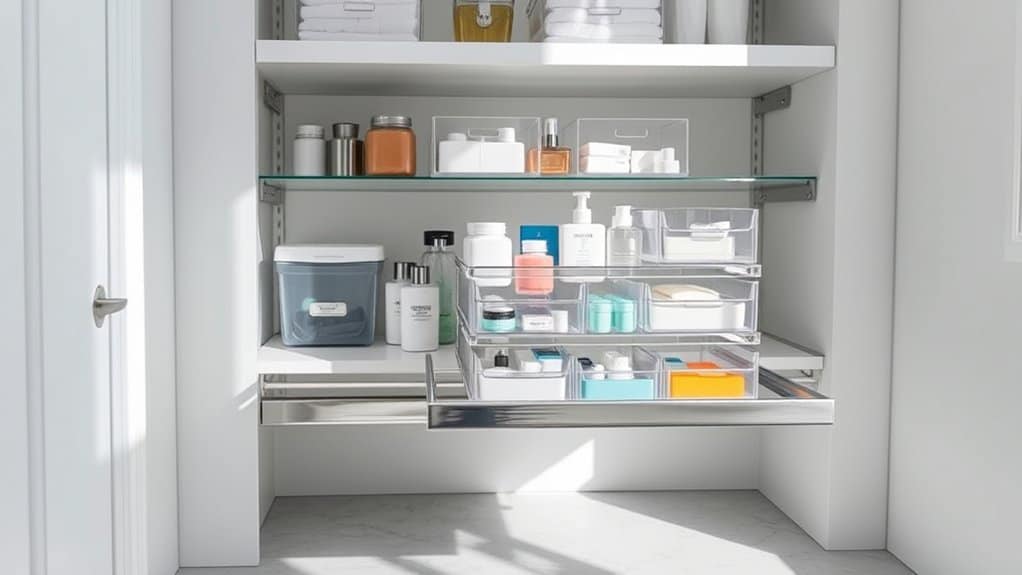
Deep bathroom shelves can quickly become cluttered black holes where items get lost and forgotten. Without proper organization, these spaces often lead to duplicate purchases and expired products, wasting both money and valuable storage space.
Pull-out organizers transform hard-to-reach deep shelves into accessible, efficient storage solutions. These sliding systems bring items from the back of shelves forward, making everything visible and within easy reach, while maximizing the full depth of your storage space.
Required Items:
- Pull-out drawer organizers or sliding shelf systems
- Measuring tape
- Screwdriver
- Mounting screws
- Level
- Pencil
- Drill (if needed)
- Storage bins or containers
- Non-slip shelf liner
Installation and organization starts with accurate measurements of your shelf depth, width, and height to select appropriately sized pull-out systems. Remove all items from the shelf and clean thoroughly.
Install the sliding mechanism according to manufacturer instructions, ensuring tracks are level and securely mounted. Most systems require attaching side-mounted tracks and then sliding in the removable baskets or drawers.
Once the hardware is installed, sort bathroom items into categories such as hair care, skincare, dental products, and first aid supplies. Place frequently used items in the front portion of pull-out containers, with less-used items toward the back.
Consider using clear bins or labeled containers within the pull-out system to maintain organization and prevent items from shifting during movement.
For optimal long-term organization, implement a quarterly review system to check for expired products and maintain the organizational structure. Add non-slip liner to prevent items from sliding during drawer movement, and consider installing motion-sensor lights for better visibility in deep shelf spaces.
Keep a small step stool nearby if upper shelves are difficult to reach, ensuring safe access to all organized areas.
Design a Daily Essentials Zone
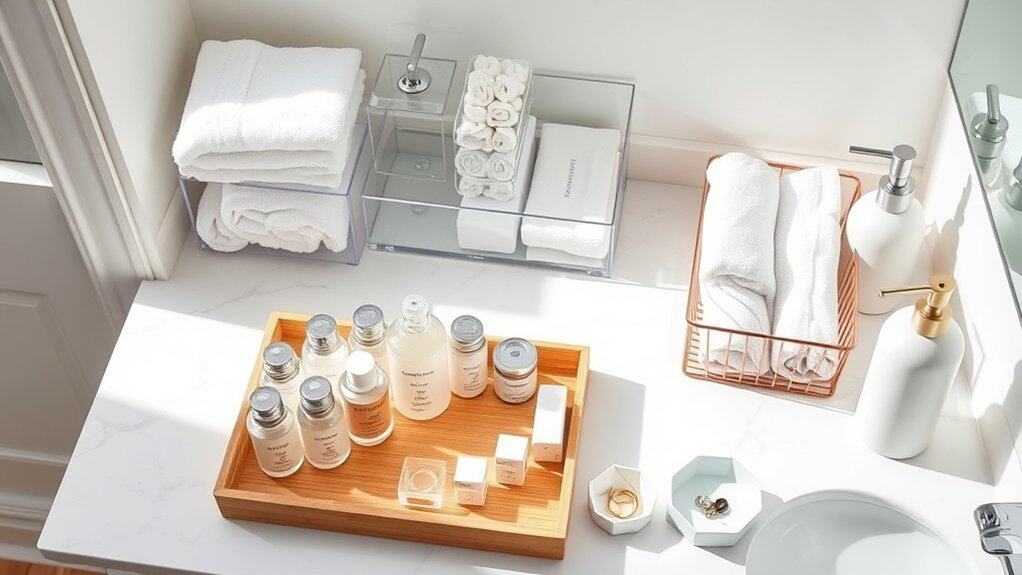
Creating a dedicated daily essentials zone in your bathroom transforms your morning and evening routines into seamless experiences. Rather than rummaging through drawers and cabinets, having frequently used items within arm’s reach saves precious time and reduces stress during rushed mornings.
A well-organized daily essentials zone not only streamlines your routine but also helps maintain bathroom cleanliness and order. When items have designated spots, they’re less likely to clutter countertops or create chaos in cabinet spaces, making cleaning easier and ensuring products remain visible and accessible.
Required Items:
- Clear storage containers
- Drawer organizers or dividers
- Small baskets or trays
- Labels or label maker
- Command hooks or adhesive strips
- Small shelving unit (if needed)
- Clear mason jars or containers
- Drawer liners
- Tension rods (optional)
Start by identifying your true daily essentials – items used at least once daily during your grooming routine. Group these items into categories such as dental care, skincare, hair care, and personal hygiene. Select appropriate storage solutions based on your space constraints and item categories.
Install a small shelf or utilize counter space near the sink, ensuring everything remains within comfortable reach. Position items according to your morning sequence, with most-used products at eye level or easily accessible spots. Use clear containers to store smaller items like cotton swabs or hair ties, and implement drawer organizers for products that need to stay hidden but readily available.
Consider using vertical space by installing adhesive hooks or small wall-mounted organizers for items like hair tools or washcloths.
Additional Success Tips:
Maintain the organization by conducting weekly quick-checks to return misplaced items and wipe down containers. Rotate seasonal products out of the daily essentials zone, and regularly assess whether items truly belong in this high-priority space.
Consider keeping backup supplies in a separate location to avoid overcrowding, and replace items in their designated spots immediately after use to maintain the system’s effectiveness.
Set Up a Stock Rotation Schedule
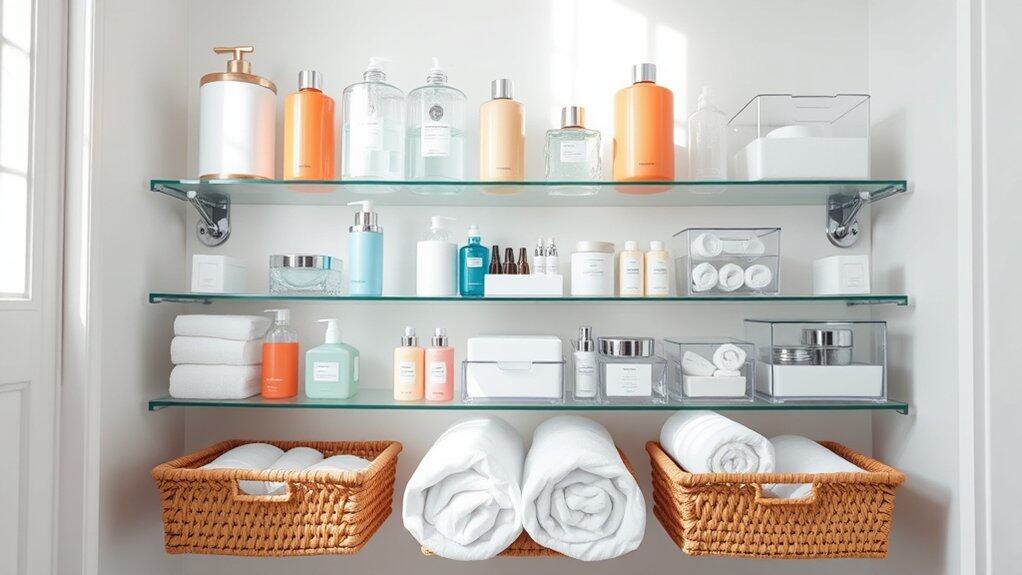
Maintaining a well-organized stock rotation system in your bathroom is crucial for preventing product waste and ensuring you always have essential items on hand. A proper rotation schedule helps track expiration dates, manages inventory effectively, and eliminates the frustration of running out of necessary items at inconvenient times.
Creating a systematic approach to bathroom stock rotation not only saves money by preventing overbuying but also helps maintain the quality of products. Many bathroom items, from medications to skincare products, have specific shelf lives and perform best when used within their recommended timeframes.
Required Items:
- Label maker or waterproof labels
- Clear storage containers
- Inventory tracking notebook
- Permanent marker
- Small adhesive tabs
- Storage baskets
- Shelf liner
- Clear drawer organizers
The stock rotation process begins with a thorough inventory of all bathroom supplies, noting purchase dates and expiration dates. Group similar items together and arrange them in clear containers with older products at the front and newer ones at the back.
Create dedicated zones for different categories: first aid supplies, personal care items, cleaning products, and paper goods. Implement a “first in, first out” (FIFO) system by marking purchase dates on items and establishing a consistent schedule for checking stock levels and expiration dates.
When new products arrive, place them behind existing stock and update your inventory list accordingly. Schedule monthly checks to review what needs replenishing and what items are approaching their expiration dates. Keep a running shopping list in your tracking notebook to ensure timely replacements of items running low.
For optimal results, establish a minimum quantity threshold for each item and mark these levels on containers or in your tracking system. Consider seasonal needs when planning stock levels, and maintain a separate area for backup supplies.
Regular assessment of your usage patterns will help refine the system over time, ensuring your rotation schedule accurately reflects your household’s needs.

